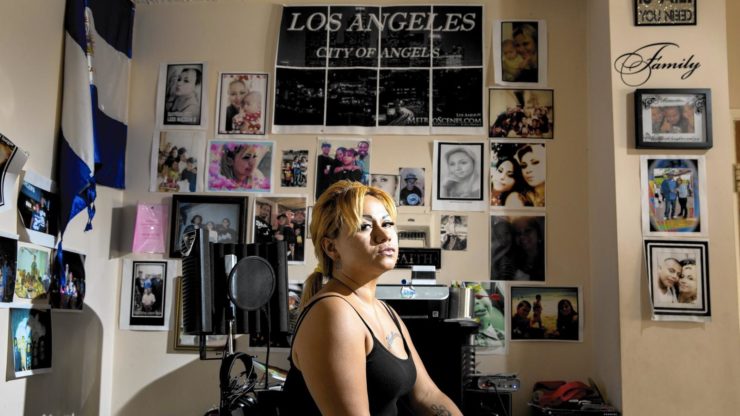
Aspiring actress Krupskaia Gutierrez was asked for money after she read monologues in front of a woman at One Source Talent.
Daniel Miller’s coverage of the film business for the Los Angeles Times typically involves tracking the latest moves of the industry’s glitzy corporate behemoths. For his five-part series “Selling Stardom,” he dug into Hollywood’s darker side.
People have a vision of Hollywood as this gleaming place, and we know that’s not always the case.
A finalist for the Loeb Awards last year, the series uncovered a slew of shady businesses that have sprung up to serve Hollywood hopefuls fresh off the latest Greyhound bus. There are the talent agents who illegally pocket clients’ paychecks, the talent listing services sucking up cash from aspiring actors, the expensive packages promising to qualify filmmakers for the Oscars. Miller also infiltrates a Christian acting seminar, one of the ever-growing variety of niche courses and workshops promising a fast track to stardom. (“And then that’s when I heard God say, ‘You are to go be a light in the darkness of Hollywood.’”)
The tale of the ingénue who arrives in Hollywood only to be preyed upon by hucksters and vultures is as old as the industry. But Miller shows us that predatory agents and services are an industry of their own, systematically exploiting aspiring artists.
He also shows us that, for the most part, authorities haven’t taken the problem seriously. When Miller approached victims, some of them couldn’t believe that a reporter would be interested in their experience — they blamed themselves. The way Miller tells the story makes us take it seriously.
We also catch glimpses of what the suspect operators have to say for themselves. In one of the most telling and bizarre moments of the series, an agent accused of taking money owed to her clients jokes that she’d only discuss her clients in detail if Miller agreed to coauthor a book with her that she’d title “Bad Agent.” Then she starts crying.
“I know I’ve ended up hurting some people — I didn’t mean to,” she tells him. “It’s not who I am — I am not a bad person.”
The L.A. Times’ Jay Clendenin, a photographer better known for his portraits of Hollywood stars, pulls the series together with intimate images that put a human face on the performers who are paying the price.
I interviewed Miller about the series; his answers are below, edited for clarity and flow.
You have to love a business where there’s no shortage of outsiders who show up every year and say, “I can do this better than people who’ve been doing it forever.” Sooner or later, those people are usually walking away with their tail between their legs.
Your job is to cover the film business and corporate Hollywood. How did this series come about?
I’ve always been drawn to the periphery of the business. People have a vision of Hollywood as this gleaming place, and we know that’s not always the case. I’d been hearing some rumblings about an uptick in crime on the edges of the business, and my editor John Corrigan, who’s now at the Wall Street Journal, encouraged me to do “longline fishing” — to go out and work the beat. I had lunches with agents, sat in on acting classes at a local theater, attended a seminar for young actors. Slowly the story ideas started to come, and I developed a network of sources removed from mainstream Hollywood. It took a while for the actors to trust me. Some were worried about being blackballed. Eventually, I built up a group of sources that were willing to tell their stories.
Tell me a bit more about your reporting process.
I spent a couple of weeks really hitting the pavement and talking to agents and actors. Some names and companies started coming up in conversations, and I developed a shortlist of people and companies I might want to write about. From there it was traditional research: looking at court records, talking to others who have done business with them, even turning to resources like Yelp and the Better Business Bureau to see what people were saying publicly. From that I was able to winnow it down to a list of entities I wanted to look at for these stories. We hadn’t done a series on the underbelly of Hollywood in some time at the L.A. Times, so it was fertile territory for us to explore.
You had five stories come out on roughly a weekly basis in the paper. How did you and your editors decide this should be a series? What were the advantages and challenges that came with that?
To me the series format made sense because it became apparent, sadly, that there was a diversity of questionable activity on the fringes of Hollywood. Rather than lump all these storylines into one or two pieces, it made sense to break them up and give them room to breathe. It helped that “Selling Stardom” was a rubric that could apply to all sorts of activities.
The first three stories were the product of initial reporting I’d done and essentially written at the same time. Believe it or not, at one point they were grouped together into an exceedingly long and unreadable single story, but ultimately we pulled them apart. The other two stories developed later as a result of tips and leads. I had kind of planted a flag in this space of covering shady behavior on the fringes of Hollywood. It was certainly ambitious to try to connect the dots between these disparate storylines and keep the through-line in place. Editors with a lot of experience pulling stuff like this off were instrumental in making sure we did it the right way.
How did you negotiate trying to make the stories flow and be engaging, with the legalese and “declined to comments” you had to include?
I thought about that quite a bit. It was important that the stories be anchored by anecdotes from performers who were mistreated — without them, these stories wouldn’t exist. There are narrative details about their lives, situations and hopes in the industry. But a lot of the stories were rooted in lawsuits, and I had to include the perspective of business executives. Narrative was deployed judiciously and frankly sometimes had to be set aside in order to handle some of the technical aspects of the stories, like weaving in details of the case and making sure people had a chance to respond to allegations. That was a big balancing act.
Do you feel that the story had an impact?
I was really heartened by the responses from the acting community and some talent agents and managers. In particular, I heard from actors who said, “This happened to me, and I didn’t think anybody cared.”
In the wake of the stories coming out, there was a monetary settlement reached in one of the lawsuits against Lynn Venturella, the talent agent I wrote about. A class-action suit against a talent listing firm I wrote about was also settled. Whether that was a result of my stories, I certainly couldn’t say, but those were events that made a lot of people in this world happy to see. I still hear from actors occasionally who say, “I was thinking of signing up with this agent or company, and I saw your story and just want to thank you.” As a reporter, there’s nothing more gratifying than that.
What do you enjoy about covering entertainment?
I love writing about the business side of Hollywood because it’s endlessly fascinating. You have to love a business where there’s no shortage of outsiders who show up every year and say, “I can do this better than people who’ve been doing it forever.” Sooner or later, those people are usually walking away with their tail between their legs. But for every story like that, there’s a wild success story. It’s a world that clearly intoxicates people, and that’s what makes it so fun.


